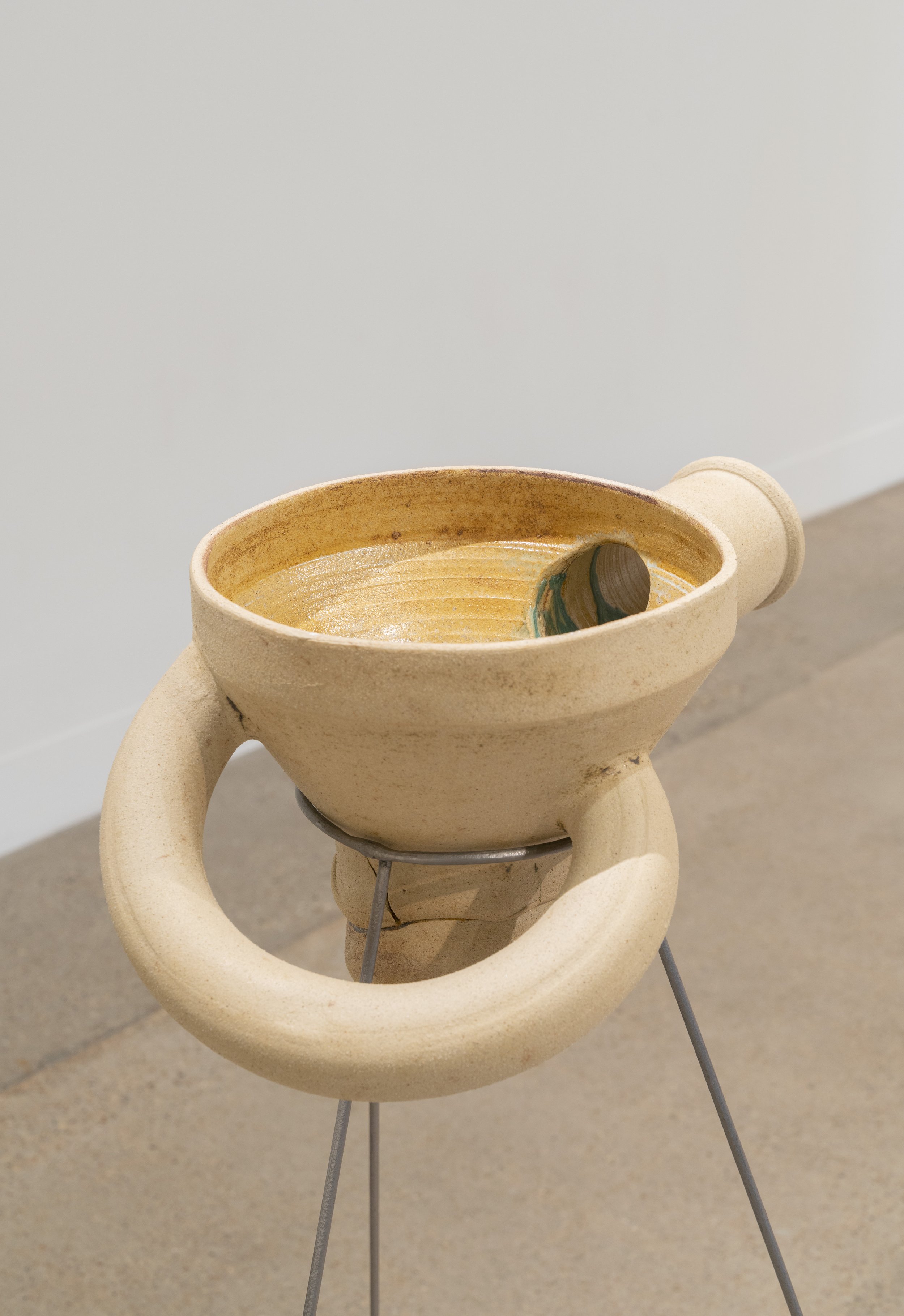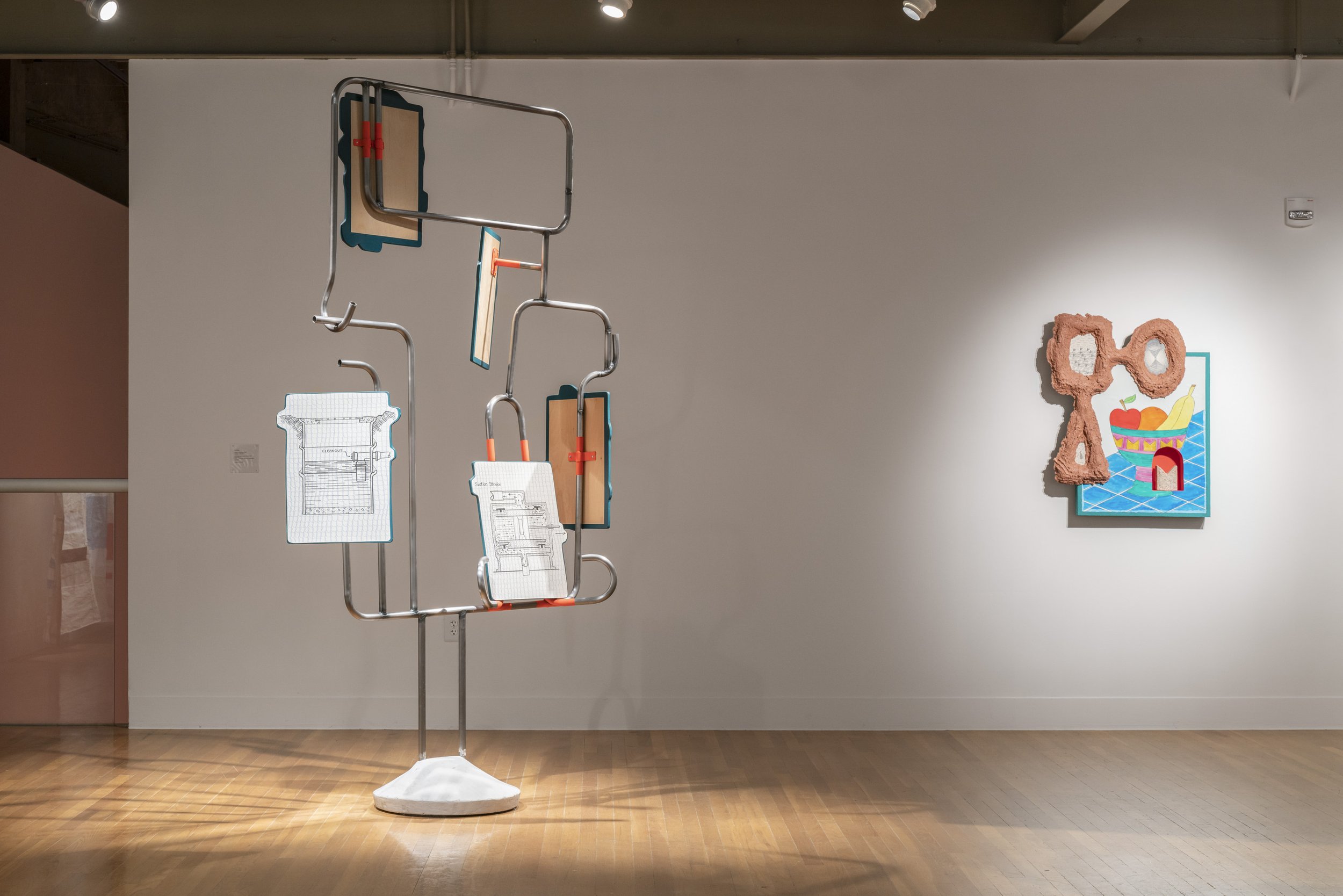CURRENT EXHIBITION at Cage Match Project in Austin, TX
Cage Match Project, ROUND 21: cullective
Exhibition Dates: April 13th - July 7th, 2024 (visible 24/7)
OPENING: Saturday, April 13th 3-5pm
3600 Lyons Road, Austin, TX
Round 21: cullective by Texas based artist Ariel Wood exposes a selective gathering. The installation invokes a possible system of water collection, yet elements are either still needed or slowly being taken away. There's a suggestion of past or future use, yet current stasis. The form of a water tower is built with steel beams woven together with blue twine. Ceramic thrown and altered pipes and vessels are held in alignment via welded steel structures bolted to concrete pavers. Each element holds the potential for collection and conveyance, yet falls short of this linear progression. The structure of the cage itself, appearing to be parked permanently—its days of fluid mobility have come to a close—is wrapped in a burlap scrim disrupted by varying sizes of cut circular vents or viewing portals. Partially protected from both sight and the elements. Round 21: cullective utilizes the relationships inherent to the exploded-view diagram—a lack of delineated function and an emphasis on labor—to call attention to access, control, and connection or a lack thereof.
Cage Match Project (CMP) is a temporary, site-specific art installation series in which selected artists are invited to engage a large, industrial caged-trailer. Measured at 20ft x 8ft x 7ft, the weathered and rusted container resides in the exterior lot of The Museum of Human Achievement in Austin, TX where it is under constant exposure to the elements and 24-hour public viewership. CMP is curated by Aryel René Jackson. www.cagematchproject.com
RECENT EXHIBITION at ICOSA collective in Austin, TX
Window Dressing XXXI : To Suggest A Delay
Exhibition Dates: Oct.30– Nov. 6th, 2023 (visible 24 hours/day)
“In their practice, Ariel Wood makes objects and structures evoking plumbing and drainage. This system of infrastructure is inherently physical as it is political. Fluidity is indelibly controlled by gravity and requires the utmost connection between parts. Structures and spaces of drainage and plumbing often control and direct the human bodies that encounter them, as much as they purport to assist them. This mix of physical materiality and sociopolitical pressures gives drainage infrastructure an implicit set of relationships that Wood works to manipulate, emphasize, and transgress.
In this current body of work, Wood explores the stormwater infrastructure systems known as detention basins. These cement depressions in the ground are often found by highways, large parking lots, and tucked away in residential areas. They speak to a “last-ditch” effort as they are built purely to move large quantities of runoff away from areas prone to flooding. They do not hold the water and let it filter back into the groundwater the way retention basins do. They simply collect it, slow down its speed, and move it away. Retain is to “[imply] continued keeping” and detain is to “suggest a delay in letting go.” as defined by the Merriam Webster Dictionary.
In To Suggest A Delay, Wood represents the detention basin right beside the Canopy parking lot in drawn, lithographic form, and three dimensionally in insulation foam and papier-mâché clay. Providing both a bird’s-eye view and an aerial view, the works are icons of the thing itself, about 500 ft away.”
RECENT EXHIBITION at grayDUCK gallery in Austin, TX
raze
DUCKblind PODCAST
ARTIST TALK with Emmy Laursen on Saturday September 16th from 2-3pm
Exhibition Dates: August 26 – October 1, 2023
Gallery hours: Saturday & Sunday 12-6 or by appointment
raze is an exhibition centering bodily experiences of installation, deconstruction, extension, alteration, looking, and being seen.
Raze, as in “to pick clean; to tear down; level to the ground,” becomes directionally complicated when what is being destroyed is below ground level, or perhaps hanging from the ceilings. To bring it to the ground may not be an act of destruction; just as being shaved clean might feel like an act of rebirth.
Ariel Wood makes objects and structures evoking plumbing and drainage. This system of infrastructure is inherently physical — its fluidity requires the utmost connection between parts — as well as political. How the human body encounters a bathroom, and more specifically a public restroom, is especially charged as these spaces purport to demonstrate gender, intimacy, privacy, and hygiene. This mix of physical materiality and sociopolitical pressures gives plumbing an implicit set of relationships that Wood works to manipulate, emphasize, and transgress.
Passing for art and passing for infrastructure, Wood sees much of their practice as embodied slippage. The forms resemble elements of plumbing, yet are each made by their hands, and thus are not fully symmetrical, flush, or fitted. This concept—passing—is key to their practice. Passing has a long and fraught history in the queer community and often specifically relates to trans bodies, and gender assumption, yet can also function in relation to race, class, etc. Passing as a concept acknowledges the performance of these attributes, the way our actions, aesthetics, and attitudes may signify certain aspects of our personhood. Passing details a level of fabrication that can be awkward at times and flamboyant at others—below the radar or proudly declarative. Wood’s work plays within this performance, initially reading as familiar and ubiquitous, and on closer inspection, revealing itself to be particular, modeled, and fallible; possibly functional, yet not functioning. Perception pulled apart, rearranged, slowed down. Perhaps these qualities can then extend beyond the art object, to our built environment. Raze it to the ground, begin anew.
RECENT EXHIBITION at the Women & Their Work in Austin, TX
Clay Matters
Sat Mar 4, 2023 - Sat Mar 18, 2023
“With clay as their medium, Alejandra Almuelle, Jennifer Ling Datchuk, Terra Goolsby, Pat Johnson, Tammie Rubin, and Ariel Wood create fictional narratives, offer social commentary, and construct objects that defy easy categorization. Clay Matters reflects the remarkable diversity that the material offers including its mythologies, socio-political implications, ancestral traditions, and practical functionality.” -Women & Their Work
RECENT EXHIBITION at the Visual Arts Center in Austin, TX
Façade
January 20 – March 10, 2023
In architecture, façadism refers to the preservation of an older building’s exterior when a new structure is erected behind or around it. Museums implement institutional display as a façade in order to elevate objects into historical significance. The cultivation of grass, flowers, and other forms of landscaping can be understood as a façade for neighbors and other passersby. With this, a façade can be thought of as an outward appearance that conceals a less pleasant or creditable reality. The façades we develop, maintain, and allow to flourish play an integral role in how we interpret and interact with our surroundings—they have the potential to conceal, protect, and communicate for us and about us in various ways. However, we often overlook our relationship to surfaces and exteriors, losing our connection to the vulnerable and sincere within.
Façade brings together the work of artists from various disciplines and backgrounds, who explore the truths that exist within any given object, historical narrative, or our performances of identity. Through sculpture, works on paper, video and painting, these artists question outward appearances, both personal and communal, addressing the notion of an idealized self, replicas, false control, and performative interactions. In doing so, they attempt to uncover the motivations behind our drive to conceal, perform, and play pretend.
Exhibition artists Luna Davis and Rowan Howe allude to the body as a performative space. Annie May Johnston and Rand Renfrow question the mask of institutional display. Katy McCarthy and Jennifer Ling Datchuck investigate the construction of multi-layered identities and personas. Informed by instructional videos, Hannah Spector comments on the façade of conversation, listening, and understanding. Quinn In, Mac Benson, and Ariel Wood take inspiration from vernacular architecture to explore interconnectedness, history, and irony within public spaces. The artists in this exhibition consider façade an unignorable reality, one that begs for cultivation and control. They encourage visitors to take a critical view of façadism, examining how our attachments to performance and deception influence our experiences of the world around us.
Façade is organized by Mac Benson, Luna Davis, and Rowan Howe, with Center Space Project.
images provided by Alex Boeschenstein
RECENT EXHIBITION at Good Luck Have Fun Gallery in Austin, TX
Yours, bubble mechanisms for locating the center* from your center to your center to your center to yours,
begins with a proposition from six queer artists: that objects are teachers whose functionality lies in our capacity to pay attention to them. The exhibition space is a present moment materialized—not a hypothetical conceptualization—which hosts our collective attempt at this type of attention. The installation follows the architectural logics of both the home and the institution; works furnish the interior and relate to one another across the space, yet at the same time, try to penetrate through the space and involve its infrastructural mechanics, as if the walls, ceiling, and floor, of the gallery itself were a porous membrane. This specific network of relationships between objects and site has the potential to recalibrate dynamics between the human and the non-human forces we call architecture.
-Emily E. Lee
.
Curated by Ariel Wood
Participating artists: Gabrielle Constantine, Emily E. Lee, Joy Scanlon, Brendan Shea, Hannah Spector, and Ariel Wood
images provided by Alex Boeschenstein
.
Review by Qmmunity Editor James Scott for The Austin Chronicle





